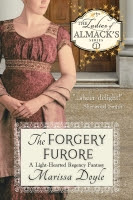Pfft!
Sorry, couldn’t resist. I did not mean the sort of raspberry
that involves sticking your tongue out of your mouth and making rude noises. I
mean the plant and its heavenly berries. You see, raspberries are by far my
favorite food. I am even now waiting for 13 plants (6 red summer-bearing, 6 red
fall-bearing, and 1 golden raspberry), to arrive from a fine nursery near the
slopes of Mt. Rainier. And my dear husband has created the perfect patch in
which to put them. I can hardly wait. So, when I stumbled across a section in La Belle Assemblée about raspberries, I
couldn’t wait to share that with you either!
The author of the article in the October 1810 edition of
that famous ladies’ magazine rhapsodizes about raspberries almost as readily as
I do.
“This . . . fruit was well known to the ancients, from whom
it received the name of Rubus, either
from the redness of the twigs of the parent plant, or from the colour of its
juice, which so often stained the taper fingers of the Roman maidens, as it
does even now with our fair countrywomen, who are not ashamed to leave the
library of science for the humbler studies of the confectionary or still-room.
In the latter, they may learn by practice how to please a husband’s taste, even
in the gratifications of the palate.”
Yes, well, I didn’t start eating raspberries for my
husband’s sake. It’s rather the other way around at my house.
“Its essential character is too minute to require
description where the fruit itself is so well known; but we must not forget to
mention that of the general genus, there are no less than thirty-two varieties,
comprising every species of the Bramble
as well as of the Raspberry.”
Thirty-two varieties? I knew there was a reason I loved
England!
“Amongst us the old name of Raspis, or Raspibsberry; in some
parts of England it is called the Hindeberry, and also Framboise, from the
French. It is believed to be indigenous with us, as it is a native of many
parts of Europe, being found not only in woods and hedges, but also in moist
situations, and even in rocky places.”
 Interesting. The raspberries I have known do not like moist
places. They hate getting their feet wet, which worries me a little here in
Western Washington. That’s one of the reasons I wanted stock from the area.
Interesting. The raspberries I have known do not like moist
places. They hate getting their feet wet, which worries me a little here in
Western Washington. That’s one of the reasons I wanted stock from the area.
“It is needless to expatiate on the estimation in which it
is held when prepared as a sweet-meat; we may, however, with propriety describe
it when ripe as a fruit of the most fragrant kind, as subacid and cooling,
allaying thirst and heat, and promoting the natural habits in common with other
summer fruits.”
Now we’re talking! In fact, the author goes on to list
several other interesting uses for raspberries in early nineteenth century
England:
- As a syrup approved for children by the College of Physicians, with instructions on its use in the Pharmacopeia
- As a way to remove tartar from teeth
- As a rather potent and rare wine
- As a dye (from the twigs) to turn wool, silk, and mohair black
- As food (the leaves) for silkworms when mulberry leaves cannot be found.







No comments:
Post a Comment